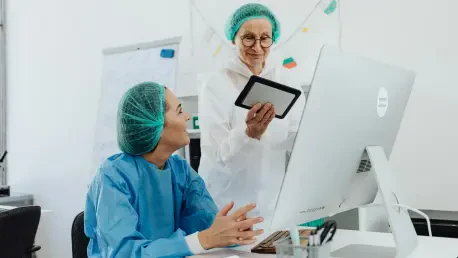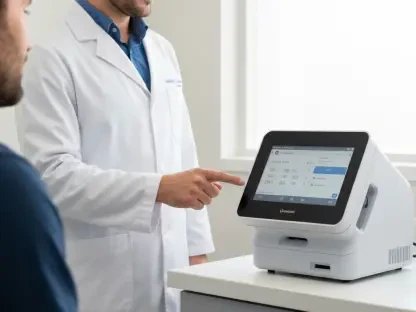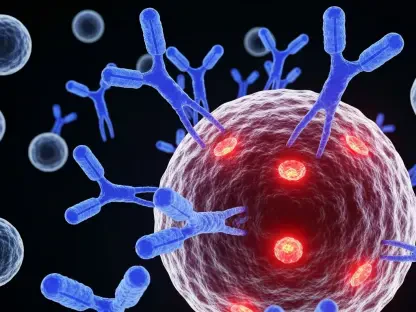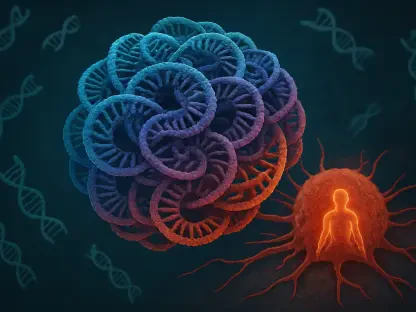The field of tissue engineering faces the persistent challenge of replicating the complex and diverse environments in which cells naturally exist. Traditional techniques often use gels to suspend cells between posts, easing tissue growth but complicating efforts to study how multiple tissue types interact. This approach, while foundational, limits researchers by restricting the ways in which they can modify composition and spatial organization, hindering more nuanced examinations of multi-tissue interactions. Addressing these challenges, the University of Washington’s interdisciplinary team has developed the Suspended Tissue Open Microfluidic Patterning (STOMP) device. STOMP is set to revolutionize the laboratory synthesis of tissues by offering a novel method to create distinct tissue regions using an open microfluidic channel, which advances cell spacing and composition manipulation without requiring cumbersome external equipment. This innovation not only simplifies tissue modeling but also enables the simulation of biological interfaces that were previously difficult to replicate, offering groundbreaking possibilities for tissue engineering advancements.
A Multifaceted Approach to Tissue Engineering
STOMP’s creation involved the intricate use of SolidWorks and Formlabs’ 3D printing technology, which allowed for precision crafting of the device’s components. By employing an open microfluidic channel, STOMP provides researchers with the ability to manipulate cellular environments with a new level of ease and precision. This is a significant departure from previous methods, which often required complex setups and precise handling of multiple external devices to achieve similar outcomes. STOMP simplifies this process, allowing for precise manipulation of every facet of the cellular environment and enhancing the flexibility and precision needed for advanced tissue studies. The ability to easily model complex biological interfaces sheds light on previously opaque areas of tissue engineering, such as the junction between bones and ligaments, which are essential for studying a wide variety of physiological processes and potential medical treatments.
Experiments using the STOMP device underscore its transformational capabilities. Researchers successfully modeled diseased versus healthy heart tissues, revealing novel insights into cellular behavior in pathological conditions. By harnessing the device’s precise patterning abilities, comparable models of periodontal ligaments were crafted, opening new avenues for dental research. These experiments highlight STOMP’s potential in furthering understanding of tissue dynamics, particularly in creating accurate disease models and advancing tissue regenerative techniques. The ability to vary tissue environments within a single sample provides a richer, more detailed view of cellular interaction and response, offering significant potential for medical breakthroughs.
Expanding Research Horizons
The success of STOMP rests on its capability to cast tissues using both synthetic and biological gels. By leveraging capillary action, the device facilitates precise cellular patterning without the intricacies traditionally associated with such techniques. This nuanced method allows the examination of cell signaling with an unprecedented level of clarity and detail, enhancing the understanding of complex intercellular communications. STOMP’s approach creates novel opportunities for studying tissue formation, degradation, and interaction at a cellular level, areas critical for advancements in medical research. The device’s effectiveness in creating varied tissue environments speaks to its ability to emulate real-life biological scenarios, crucial for developing treatments and conducting clinical trials that are more reflective of actual patient experiences.
The potential implications of STOMP’s capabilities are vast. As tissue engineering increasingly influences regenerative medicine and cellular therapy, tools like STOMP could become instrumental in developing new treatments and therapies. Medical researchers can apply STOMP’s innovations to explore fundamental questions about organ function and disease, accelerating the pace of discovery in these vital areas. Furthermore, the device’s seamless integration into existing research frameworks means it can foster new insights with minimal disruption—paving the way for therapeutic approaches that are safer and more effective. As the STOMP device proves its utility in a wide array of scientific endeavors, its role in shaping future research and medical landscapes appears indispensable.
Charting New Territories in Biomedical Research
Tissue engineering constantly grapples with the challenge of replicating complex environments that exist in nature for cell growth. Typical methods utilize gels to suspend cells between posts, facilitating tissue formation but complicating the study of interactions among various tissue types. While these techniques are foundational, they often restrict researchers from altering composition and spatial layout, limiting deeper explorations into multi-tissue dynamics. Tackling these obstacles, a team from the University of Washington has developed the Suspended Tissue Open Microfluidic Patterning (STOMP) device. STOMP is poised to transform tissue synthesis in labs with a cutting-edge method that uses open microfluidic channels to generate distinct tissue areas, enhancing cell arrangement and composition management without using bulky equipment. This breakthrough simplifies tissue modeling and enables the replication of biological interfaces previously difficult to simulate, opening the door to unprecedented advancements in tissue engineering.









